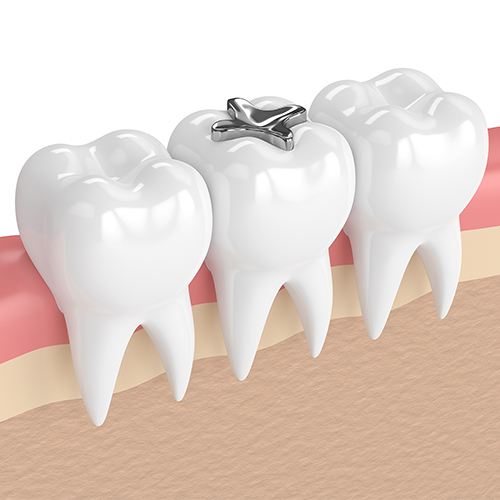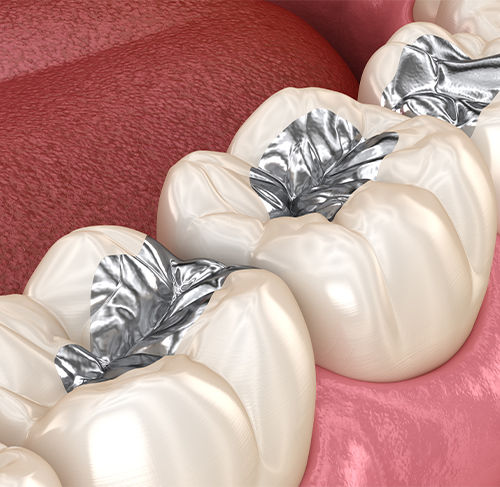Dental “Mercury” Amalgam AKA “Silver” Dental Fillings
Mercury used in dental amalgam has been used for almost 200 years. While these fillings have been deceptively called “silver” amalgam fillings, they are actually about 50% mercury, along with silver, copper, tin, and zinc. They have been called “silver” due to the color and not by the content of materials. In products around the globe, the major ingredient is always listed first, so these dental fillings, should actually be called “mercury” amalgam fillings.
Mercury used in dentistry accounts for about 340 tons used around the world each year, which according to the United Nations Environmental Programme is about 1/5 of all mercury used in products and processes world-wide.
The definition of a poison: A substance that is capable of causing the illness or death of a living organism when introduced or absorbed. According to Medscape: Mercury in any form is poisonous, with mercury toxicity most commonly affecting the neurological, gastrointestinal (GI) and renal organ systems. Poisoning can result from mercury vapor inhalation, mercury ingestion, mercury injection, and absorption of mercury through the skin. (SOURCE)
Now, there is an international treaty designed to protect human health and the environment from anthropogenic emissions and releases of mercury and mercury compounds. The treaty is called the “Minamata Convention on Mercury Treaty”, named after a city in Japan where an industrial company named the “Chisso Corporation” was dumping mercury waste into the bay.

This was the first globally recognized contamination of mercury that impacted an entire fishing community. This treaty, aptly named for this catastrophic event, went into force August 16, 2017.
MERCURY AMALGAM FILLINGS SHOULD ONLY BE REMOVED BY DENTISTS WITH EXPERIENCE USING A SAFE REMOVAL PROCEDURE LIKE THE HUGGINS-GRUBE PROTOCOL.
While there are many products and processes that are being banned in 2020, dental mercury amalgam is the only intentional use product, that is implanted in the human body, that is only a phase down product. This, however, has not stopped many countries to take their own initiative to ban it such as Indonesia, the fourth largest populated country in the world, Madagascar, Nepal, with Norway, Denmark, and Sweden who have banned its use many years ago.
We must ask why, with the science proving the negative health effects and alternatives widely available around the globe, does this known neurotoxin continue to be used, especially in developed countries, such as the United States, Canada, Australia, and New Zealand.
STATEMENT ON DENTAL AMALGAM
Dental amalgam has been studied and reviewed extensively, and has established a record of safety and effectiveness.
The FDA says: On July 28, 2009, the U.S. Food and Drug Administration (FDA) issued its final rule on encapsulated dental amalgam classifying amalgam and its component parts, elemental mercury and powder alloy, as a class II medical device. Previously there was no classification for encapsulated amalgam, and dental mercury (class I) and alloy (class II) were classified separately.
This new regulation places encapsulated amalgam in the same class of devices as most other restorative materials, including composite and gold fillings. At the same time, the FDA also reaffirmed the agency’s position that the material is a safe and effective restorative option for patients.
For dental patients: Please visit the ADA’s Mouth Healthy website for information about amalgam and silver-colored fillings. (ADA SOURCE)
DENTAL AMALGAM
(SiLVER FILLINGS)

Dental amalgam is considered a safe, affordable and durable material that has been used to restore the teeth of more than 100 million Americans.
Amalgam contains a mixture of metals such as silver, copper and tin, in addition to mercury, which binds these components into a hard, stable and safe substance.
Unfortunately for humanity, STATEMENTS ABOUT DENTAL AMALGAM from dental trade organizations – LIKE THE ONE ABOVE – continue to claim complete safety of the use of mercury amalgam fillings.
GENETIC ASPECTS OF SUSCEPTIBILITY TO MERCURY TOXICITY

The APOE gene provides instructions for making a protein called apolipoprotein E. This protein combines with fats (lipids) in the body to form molecules called lipoproteins.
Lipoproteins are responsible for packaging cholesterol and other fats and carrying them through the bloodstream. Maintaining normal levels of cholesterol is essential for the prevention of disorders that affect the heart and blood vessels (cardiovascular diseases), including heart attack and stroke.
There are at least three slightly different versions (alleles) of the APOE gene. The major alleles are called e2, e3, and e4. The most common allele is e3, which is found in more than half of the general population. (SOURCE REFERENCES)
FOLLOWING THE SCIENCE
SMOKING TEETH
The American Dental Association (ADA) says that dental amalgam is considered a safe, affordable and durable material that has been used to restore the teeth of more than 100 million Americans. It contains a mixture of metals such as silver, copper and tin, in addition to mercury, which binds these components into a hard, stable and safe substance. Dental amalgam has been studied and reviewed extensively, and has established a record of safety and effectiveness.
However, the science says otherwise. In fact, while the American Dental Association still claims that it is a hard and stable substance, the link to this groundbreaking video shows the truth about mercury off gassing on a 25-year-old dental mercury filling.
DR. HAL HUGGINS
A DENTIST AHEAD OF HIS TIME

Dr. Hal Huggins and Dr. Blanche Grube
In 1998, Dr. Hal Huggins and Dr. Thomas Levy published a paper titled “Cerebrospinal Fluid Protein Changes in Multiple Sclerosis After Dental Amalgam Removal”. This paper is of particular importance as it discussed the very specific protocol for the treatment of his patients, doing a complete dental revision.
“Although the primary thrust of this study explores the relationship between mercury and the neurological system, some early controversial research implicated root canal filled teeth in neurological diseases, although not MS specifically. Root canal filled teeth was included in the patient treatment protocol.
This article addresses the possibility that dental materials, specifically those including mercury, may be an important factor in producing the abnormal protein profile seen in the Cerebrospinal Fluid (CSF) of MS patients. Changes in the patterns and amounts of CSF proteins never before reported have been found in CSF specimens of MS patients after undergoing a multi-disciplined treatment protocol.
This protocol included replacement of all amalgams with composite fillings and removal of root canal filled teeth and other infected teeth. Additionally, the treatment included medical, dental, psychological, nursing, nutritional, and neuromuscular therapies. Intravenous vitamin C, along with several detoxification procedures, was also utilized.” READ DR. HUGGINS’ PAPER ON M.S. HERE
Below are links to peer reviewed scientific research on some specific topics related to mercury in dental amalgam, however, the industry and many government agencies continue to completely ignore the science. We are highlighting some of the research with specific diseases and exposures.
MERCURY & AMALGAM
Mercury amalgam fillings have been linked to many health complications such as, neurological problems and gastrointestinal problems. The research continues to grow in these areas and this is particularly important in the aging population.
A paper published by Mutter (2011) titled, “Is dental amalgam safe for humans? The opinion of the scientific committee of the European Commission”, is where he took the claims of the Scientific Committee on Emerging and Newly Identified Health Risks (SCENIHR) that stated, “no risks of adverse systemic effects exist and the current use of dental amalgam does not pose a risk of systemic disease” and refuted each statement with a plethora of peer-reviewed scientific research. This is one of the most comprehensive papers on the topic of mercury amalgam fillings. This paper has almost 300 cited published research papers and covers many aspects of mercury toxicity from this source. This is a must read for anyone who suspects a health problem that could be caused by exposure to mercury dental fillings. (REFERENCES)
OCCUPATIONAL MERCURY EXPOSURE
Dental professionals are often exposed to mercury in dental fillings, even if they are not placing them, but removing them. The following links show the negative effects of this occupational exposure. (REFERENCES)
MERCURY & FERTILITY
Dental amalgam exposure and fertility problems are often a factor that is not considered in medicine, however, there is science that shows that this is a potential risk factor for a couple. (REFERENCES)
MERCURY & MULTIPLE SCLEROSIS
According to the National Institute of Health (NIH) Multiple sclerosis (MS) is a nervous system disease that affects your brain and spinal cord. It damages the myelin sheath, the material that surrounds and protects your nerve cells. This damage slows down or blocks messages between your brain and your body, leading to the symptoms of MS. They can include:
- Visual disturbances
- Muscle weakness
- Trouble with coordination and balance
- Sensations such as numbness, prickling, or “pins and needles”
- Thinking and memory problems
No one knows what causes MS. It may be an autoimmune disease, which happens when your immune system attacks healthy cells in your body by mistake. Multiple sclerosis affects women more than men. It often begins between the ages of 20 and 40. Usually, the disease is mild, but some people lose the ability to write, speak, or walk. (REFERENCES)
MERCURY & ALZHEIMER’S DISEASE
Mercury / Alzheimer’s Disease connection, studies are showing the relationship of mercury exposure and Alzheimer’s Disease. Alzheimer’s disease (AD) is a progressive, irreversible, and currently incurable neurodegenerative disorder, and the leading cause of dementia worldwide. (REFERENCES)
AN INTRODUCTION TO BIOCOMPATIBILITY TESTING AND WHY IT’S SO IMPORTANT
Biocompatibility tests are extremely important in determining which composite materials can be safely used. While composite resin fillings are a better replacement than metal fillings, even in chemically-sensitive individuals, they are not without safety questions. Proper placement of composites should be left to experienced amalgam removal dentists as the average well-meaning dentist may not be aware of the newer placement techniques.
Even though there are composite resin materials that are compatible with many patients, there really is no “one size fits all material”, therefore, it is advisable to use the least reactive restorative materials for the individual patient. That is why Dr. Huggins developed the biocompatibility test. He always was looking at how to achieve the best possible outcome for the patient and realized that he never wanted to send the patient from the “frying pan into the fire” by not looking at the patient as an individual and replacing the mercury fillings with another toxic material.
This is what a recently published scientific paper concluded about biocompatibility of dental materials, “It is essential to use healthy and safe materials medical approaches. In dentistry, application of different material in long-term oral usage demands low or non-toxic agents gains importance for both patients and the staff. Furthermore, screening tests should evaluate any potential toxicity before clinical application.” Shahi, et al. (RESOURCES)
SUMMARY
Obviously, not everyone experiences acute toxicity effects from the mercury in amalgam fillings. However, virtually everyone does have mercury build up in their bodies from implantation of such fillings. The large increase in mercury exposure from the newer non-gamma-2 mercury fillings means that only time will tell how much damage has been caused by daily exposure to mercury because of these fillings.
Mercury amalgam fillings should only be removed by dentists with experience using a safe removal procedure, such as the Huggins- Grube Protocol. Such dentists are often experienced with proper evaluation and placement of composite fillings, both of which can be crucial for the success of the treatment. Biocompatibility tests are extremely important in determining which composite materials can be safely used.
While composite resin fillings are a better replacement than metal fillings, even in chemically-sensitive individuals, they are not without safety questions. Proper placement of composites should be left to experienced amalgam removal dentists as the average well-meaning dentist may not be aware of the newer placement techniques.

